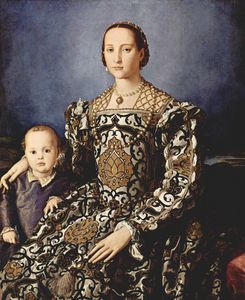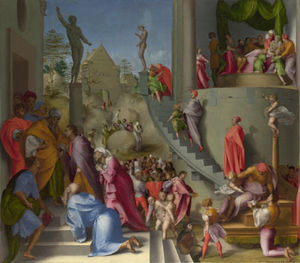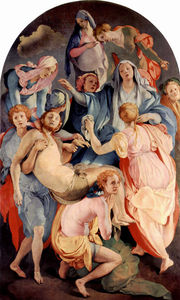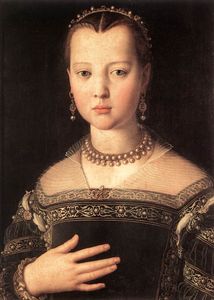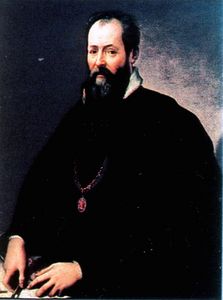Agnolo Bronzino Biography
- Full Name:
- Agnolo di Cosimo
- Short Name:
- Bronzino
- Alternative Names:
- Il Bronzino, Agnolo Bronzino
- Date of Birth:
- 17 Nov 1503
- Date of Death:
- 23 Nov 1572
- Focus:
- Paintings
- Mediums:
- Oil, Tempera, Metal, Wood, Other
- Subjects:
- Figure
- Art Movement:
- Mannerism
- Hometown:
- Florence, Italy
- Agnolo Bronzino Biography Page's Content
- Introduction
- Early Years
- Middle Years
- Advanced Years
Introduction
Agnolo Bronzino, born Agnolo di Cosimo but most commonly referred to as Bronzino, was a stand-out artist of the second-wave of Italian Mannerism in the middle of the 16th century. He lived his entire life in Florence and modeled his painting style so closely to his Italian Mannerist mentor, Jacopo Pontormo, that art historians today still debate the origin of several paintings.
Succeeding where Pontormo had not, Bronzino eventually became court painter to the powerful Medici family of Florence and became famous for his portraiture style which meshed a detached realism, depicting cold and often arrogant expressions of his noblemen sitters, with bold colors such as ice blue and raspberry red. His portraits have proven to be his primary legacy and influenced portraiture painting for a century following his death in 1572.
Agnolo Bronzino Early Years
Nickname mystery
It's unknown exactly where the nickname Bronzino came from. Bronzino literally means "bronze-colored," but some historians hypothesize that he may have received the name because of his dark complexion or the way we would often paint his subjects with bronze-like skin. It's also been hypothesized that Bronzino had Addison's disease, which affects the adrenalin glands and can increase skin pigment.
-

Joseph with Jacob in Egypt
-

The Deposition from the Cross
Bronzino was born on November 17, 1503, in the town of Monticello outside Florence to a poor family; his father was a butcher. He started his art education at the age of 11 as a pupil of Raffaellino del Garbo, a Florentine Renaissance painter. Garbo offered the young Bronzino only a rudimentary art education and so aged 12, Bronzino undertook an apprenticeship in Florence with the man who would become his biggest artistic influence and, some say, adopted father: Jacopo Carucci, better known as Pontormo.
This same year, perhaps in a prophetic statement of the close personal connection the two artists would share until Pontormo's death in 1557, Pontormo painted the young Bronzino into a piece he was working on called Joseph in Egypt, completed in 1518. Georgio Vasari, the Italian artist, biographer and Mannerist painter says that from early on Pontormo had great affection for Bronzino and the two were almost inseparable.
If what some historians say is true, Pontormo adopted Bronzino as his son once Bronzino was an adult (other historians insinuate that the relationship shared by the two artists was closer to a homosexual love affair). Regardless, it's clear that Pontormo took Bronzino under his wing at an early age and the two remained close for many years. Pontormo allowed Bronzino to work on some of the paintings he was commissioned to paint whereas other students of Pontormo's were not granted so much responsibility.
Thus, much of Bronzino's life and career until the 1530s was spent at Pontormo's side and consequently Bronzino adopted Pontormo's painting style almost entirely as he developed his own, which didn't materialize until much later in his career. The commonalities of the two artists' styles hit a peak in the 1530s and 40s.
In 1522, when Bronzino was 19 years old, the plague broke out in Florence and so Pontormo and his apprentice left the city to avoid the Black Death. They ventured just three miles outside of Florence, at the Certosa di Galuzzo, a cloistered Carthusian monastery where the monks followed vows of silence. They arrived at this particular location on the outskirts of Florence because Pontormo had been asked to paint some frescoes there. The frescoes that Bronzino helped to paint were of the Passion of the Christ.
There are not many examples of Bronzino's independent work from his childhood until the late 1520s. Bronzino either stuck solely to assisting Pontormo and didn't endeavor his own work, or his work from his early career has been lost.
In 1925, Pontormo again called upon his pupil to help with what would become Pontormo's masterpiece: Deposition from the Cross. This altarpiece was painted in the Florentine church of Santa Felicità and Pontormo was commissioned to decorate the entire church with frescoes. In a testament to Pontormo's trust in and affection for Bronzino he allowed him to paint two of four circles. However, because the two artists' styles are so similar, historians have had difficulty deciphering which ones he painted.
Agnolo Bronzino Middle Years
Bronzino fled to Urbino after the Siege of Florence in 1530, having been invited by the Duke of Urbino to paint a nude Cupid on a spandrel of a vault of the Imperiale. Soon after he arrived, Pontormo wrote letter after letter asking Bronzino to come back.
A prince at Urbine was so impressed with Bronzino's painting that he commissioned him to paint his portrait. The prince wanted to be wearing a particular suit of armor that had not yet arrived from where it was being made, so Bronzino had to wait until the armor turned up. Pontormo sent a barrage of letters requesting his pupil's return.
While Bronzino waited he painted the frame of the prince's harpsichord, which pleased the prince greatly. When the armor eventually arrived Bronzino painted the portrait and it was well received by the prince. Once it was finished, Bronzino rejoined his teacher in Florence.
As Bronzino gained increasing recognition for his portraits, the nobility in Florence became more intrigued by the artist. The Medici Court hired Bronzino as court painter in 1939 at the age of 36. Although Bronzino was not extremely skilled in executing religious works because he lacked the passion that Pontormo had, he excelled at portraiture. He became the official portraitist for the Medici and soon went to work painting the portraits of the ruling family members, which he is now largely known for, and which is Bronzino's greatest contribution to Mannerism.
Agnolo Bronzino Advanced Years
Toward the end of Bronzino's life he helped found the Accademia dell'Arte del Disegno, translated as the Academy of the Art of Drawing, in 1563. Other founders include Giorgio Vasari and Bartolommeo Ammannati, also prominent figures in the late Italian Mannerism movement. The school was funded by the Medici.
Bronzino had many students as he worked as court painter for the Medici, which he did until his death, but none as favored as Alessandro Allori. In a move that mirrored his relationship with Pontormo, Bronzino adopted Allori as his son and moved into the Allori family house. He died there on November 23, 1572, at the age of 69.
At the time of Bronzino's death he had left some frescoes unfinished at San Lorenzo in Florence that he began in 1569. To honor his teacher, Allori completed the frescoes. Strangely enough, at the time of Pontormo's death in 1557 he was working on frescoes at San Lorenzo that he never finished, and Bronzino completed the work for his beloved teacher.


